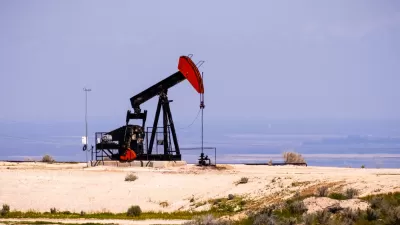While U.S. motorists are enjoying the cheapest gas prices in five years, domestic oil producers are suffering, though not as badly as oil-exporting nations like Iran, Russia, and Venezuela. How are Texas, Louisiana, North Dakota, and Alaska faring?
With Western Texas Intermediate (WTI) oil priced at a five-year low of $55 a barrel on Dec. 22, according to the Energy Information Administration (EIA), the U.S. economy as a whole is hugely benefiting as motorists have more cash to spend, but how will America's more energy-dependent states weather the world oil glut?
Manny Fernandez and Jeremy Alford write that Texas and Louisiana have diversified since "the mid-1980s, (when) oil prices sank below $12 per barrel." Of the two, Louisiana's economy remains more oil-dependent, where the price drop "had a hand in increasing the state’s projected 2015-16 budget shortfall to $1.4 billion." However, the reporters note that "(t)he portion of the state budget in Louisiana linked to oil and gas revenue is about 13 percent, compared with 45 percent in the 1980s."
In Texas, the nation's largest oil producer, "(o)il and gas jobs make up only about 3 percent of nonagricultural jobs, a far lower share than government (16 percent) and education and health services (13 percent)," write Fernandez and Alford.
However, "(t)he drop in oil prices over the last six months has amounted to a loss of $83 million per day in potential revenue for the industry in Texas, the Greater Houston Partnership said in a recent report." Yet the organization is quick to point out that they expect Houston, "which proudly bills itself as the energy capital of the world," according to the reporters, will gain almost 63,000 jobs next year according to their Dec. 11 press release [PDF].
“The uncertainty in the oil patch will be offset by the on-going boom in chemical plant construction, the region’s never-ceasing population growth and that growth’s impact on retail, restaurants and health care, the continued expansion of international air service at IAH [airport] and Hobby [Lobby], and the need to educate a growing school population” said said Patrick Jankowski, Vice President of Research at the Greater Houston Partnership.
Most of the those new jobs will not be as well-paying as the "2,300 oil and gas jobs (lost) in October and November, according to preliminary data released last week by the federal Bureau of Labor Statistics," write Fernandez and Alford. And with oil and gas revenue on the wane due to reduced drilling as well as greatly produced oil prices, one might question the wisdom of the November 4 vote by Texans to redirect energy taxes from the state's rainy day fund to the highway fund. More on rainy day funds from energy taxes written below about Alaska.
In North Dakota, the nation's #2 oil producer, "officials said a major blow to the state’s oil and gas revenues could delay one-time expenditures for highway improvement or water projects, but the state’s general operations would be relatively unscathed, since only a small portion of its oil and gas money goes toward operations," write Fernandez and Alford.
If the U.S. does have a "petro state," it would likely be its fourth largest oil producer (after California), Alaska. In fact, in a Dec. 4 piece, when oil prices were $15 higher, The Washington Post's energy correspondent, Steven Mufson, calls The Last Frontier "America’s own petro-state," and it's easy to see why.
(I)n recent years taxes on oil production have covered more than half the total budget ($13.5 billion including federal funds and capital projects) and 90 percent of the state's discretionary spending ($6.5 billion to run agencies and schools). Now, with prices under $70 a barrel, the budget deficit could balloon to more than $3 billion, about half of the state’s discretionary spending level.
However, oil taxes have funded two rainy day funds thanks to energy taxes "which are dedicated to covering deficits in lean years," notes Mufson.
Alaskans enjoy the perks of being a major oil producer just as Venezuelans do. Rather than paying a nickel per gallon gas prices as motorists do in Venezuela, Alaskans pay no sales or income taxes. And once a year, every resident receives a dividend from the Alaska Permanent Fund: $1,884 will be directly deposited into eligible residents' accounts on Jan. 15, 2015.
The Permanent Fund "is supposed to help Alaskan families as production in Prudhoe Bay declines," writes Mufson. And it is declining, though recent legislation to reduce oil taxes, upheld by voters in an August referendum, is intended to stem the tide.
Mufson writes that the rainy day and permanent funds were "supposed to make Alaska look more like Norway, which has a huge oil-financed investment fund, and less like Venezuela." [Also see
One could argue that Alaska is looking more like Venezuela than Norway as both world oil prices and its oil production declines.
Finally, Fernandez and Alford point to "(a) study published in 2013 by the Council on Foreign Relations suggested that job losses from a sharp decline in oil prices would be largest in Wyoming, Oklahoma and North Dakota."
FULL STORY: Some States See Budgets at Risk as Oil Price Falls

Planetizen Federal Action Tracker
A weekly monitor of how Trump’s orders and actions are impacting planners and planning in America.

Congressman Proposes Bill to Rename DC Metro “Trump Train”
The Make Autorail Great Again Act would withhold federal funding to the system until the Washington Metropolitan Area Transit Authority (WMATA), rebrands as the Washington Metropolitan Authority for Greater Access (WMAGA).

The Simple Legislative Tool Transforming Vacant Downtowns
In California, Michigan and Georgia, an easy win is bringing dollars — and delight — back to city centers.

The States Losing Rural Delivery Rooms at an Alarming Pace
In some states, as few as 9% of rural hospitals still deliver babies. As a result, rising pre-term births, no adequate pre-term care and "harrowing" close calls are a growing reality.

The Small South Asian Republic Going all in on EVs
Thanks to one simple policy change less than five years ago, 65% of new cars in this Himalayan country are now electric.

DC Backpedals on Bike Lane Protection, Swaps Barriers for Paint
Citing aesthetic concerns, the city is removing the concrete barriers and flexposts that once separated Arizona Avenue cyclists from motor vehicles.
Urban Design for Planners 1: Software Tools
This six-course series explores essential urban design concepts using open source software and equips planners with the tools they need to participate fully in the urban design process.
Planning for Universal Design
Learn the tools for implementing Universal Design in planning regulations.
Smith Gee Studio
City of Charlotte
City of Camden Redevelopment Agency
City of Astoria
Transportation Research & Education Center (TREC) at Portland State University
US High Speed Rail Association
City of Camden Redevelopment Agency
Municipality of Princeton (NJ)




























